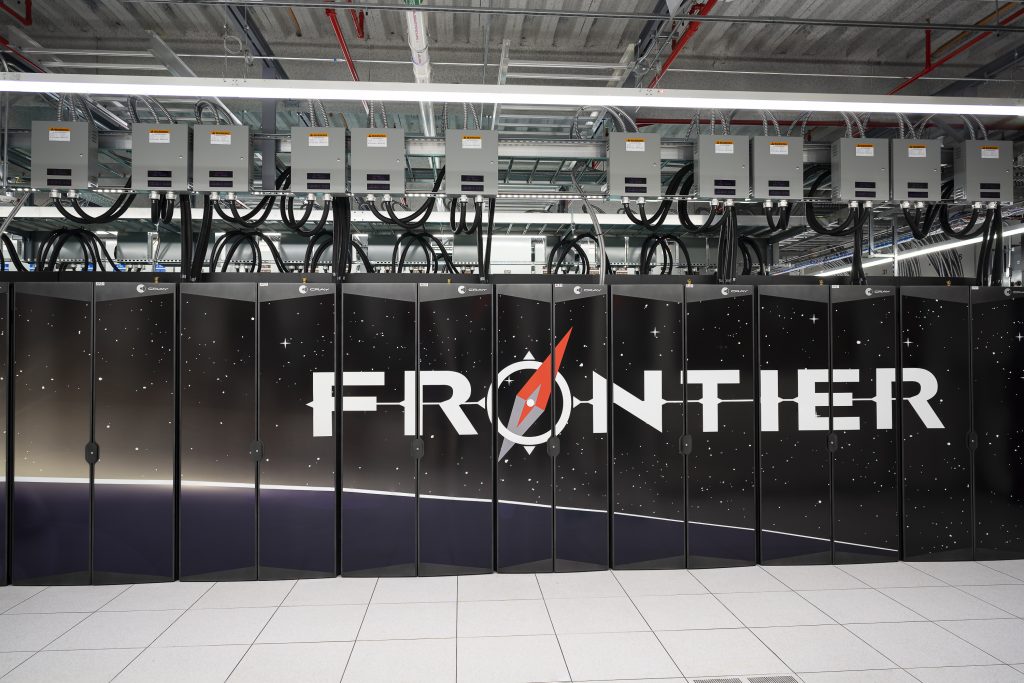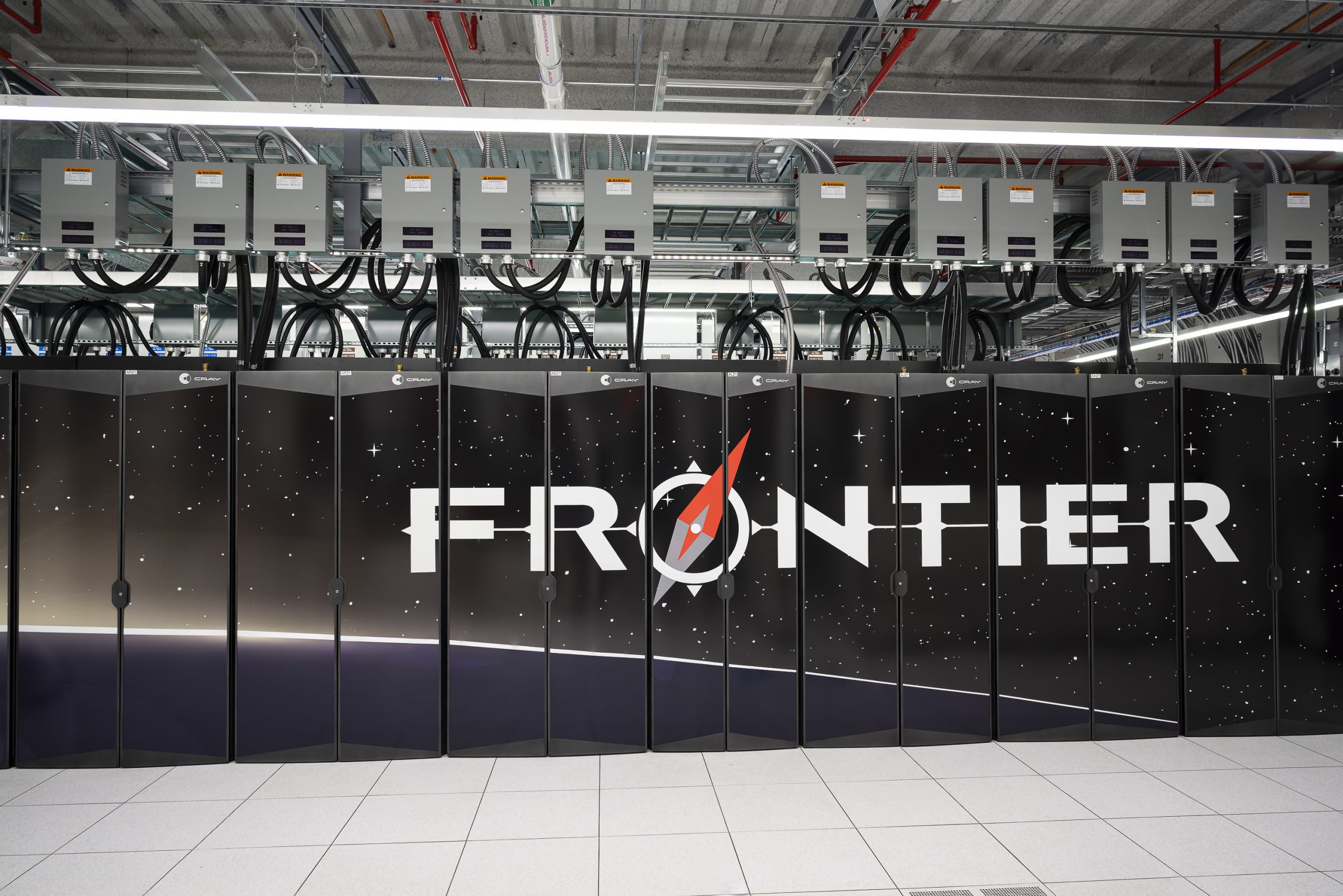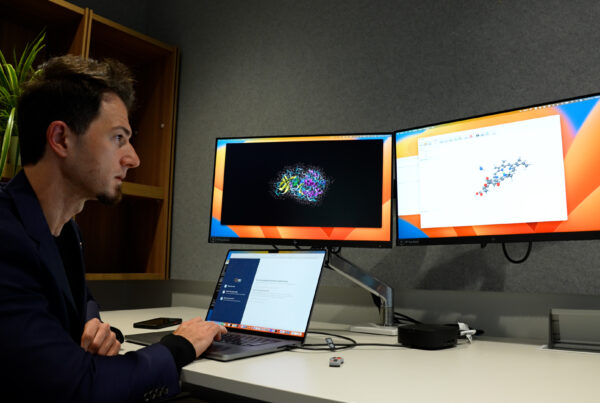The Frontier supercomputer at the U.S. Department of Energy’s Oak Ridge National Laboratory logged a new benchmark this week that further illustrates its world-changing potential and held onto its top ranking as the world’s fastest on the 60th TOP500 list.
Frontier set a new speed record for the mixed-precision calculations often used by artificial intelligence, topping its initial performance in May. The latest international supercomputing rankings also include a new score of 16 petaflops for Frontier using the High-Performance Conjugate Gradient, or HPCG, benchmark.
The system, which debuted atop the list in May at 1.1. exaflops, remains the first to achieve the unprecedented level of computing performance known as exascale at more than a quintillion calculations per second.
“These benchmarks give us a more complete picture of Frontier’s overall performance and capabilities,” said Bronson Messer, director of science for the Oak Ridge Leadership Computing Facility at ORNL, which houses Frontier. “Taken together, they indicate our intention of fielding a balanced machine, designed for modern computational science, is being borne out.”

The Frontier supercomputer remains the world’s only exascale computer and the fastest in the world at 1.1 exaflops. Credit: ORNL/Carlos Jones
Frontier promises a theoretical peak performance of 2 exaflops, or two quintillion calculations per second, making it ten times more powerful than ORNL’s Summit system. The HPE Cray EX supercomputer leverages ORNL’s extensive expertise in accelerated computing and will enable scientists to develop critically needed technologies for the country’s energy, economic and national security, helping researchers address problems of national importance that were impossible to solve just five years ago.
Rankings were announced at the International Conference for High Performance Computing, Networking, Storage and Analysis in Dallas, which gathers supercomputing experts from around the world. Frontier’s overall performance of 1.1 exaflops translates to more than one quintillion floating point operations per second, or flops, as measured by the High-Performance Linpack Benchmark test. Each flop equals a mathematical calculation, such as addition or multiplication.
Frontier’s new HPCG score seeks to measure how the supercomputer might perform when running a typical application code like those commonly used by applications awaiting their time on Frontier. Frontier clocked in at 16 petaflops, or 16 trillion calculations per second, by that standard for second place worldwide, behind the Fugaku supercomputer at Japan’s Riken Center for Computational Science.
“The HPCG test results more closely resemble the kind of performance we could expect to see when running the kinds of codes used in a day-to-day application, such as one for computational fluid dynamics problems,” Messer said. “Full application performance on these and other important applications depends not only on pure floating point rate, but also on how fast you can feed those arithmetic units from memory, something that the HPCG benchmark makes clear.”
Frontier’s mixed-precision computing performance clocked in at roughly 7.9 exaflops, or 7.9 quintillion flops per second – a full exaflop higher than its May score – as measured by the High-Performance Linpack-Accelerator Introspection, or HPL-AI, test. The HPL-AI test measures calculation speeds in the computing formats typically used by the machine-learning methods that drive advances in artificial intelligence.
Detailed simulations relied on to model such phenomena as cancer cells, supernovas, the coronavirus or the atomic structure of elements require 64-bit precision, a computationally demanding form of computing accuracy. Machine-learning algorithms typically require much less precision — sometimes as little as 32-, 24- or 16-bit accuracy — and can take advantage of special hardware in the graphic processing units, or GPUs, relied on by machines like Frontier to reach even faster speeds.
“Frontier hasn’t really changed,” Messer said. “We’re just getting better at measuring how fast it can really go and how we are actually going to harness that speed.”
Frontier dropped to second place on the Green500 list, which rates energy use and efficiency by commercially available supercomputing systems, with 62.68 gigaflops performance per watt, behind the Flatiron Institute’s Henri computer.
The work to deliver, install and test Frontier began during the COVID-19 pandemic, as shutdowns around the world strained international supply chains. More than 100 members of a public-private team worked around the clock, from sourcing millions of components to ensuring deliveries of system parts on deadline to carefully installing and testing 74 HPE Cray EX supercomputer cabinets, which include more than 9,400 AMD-powered nodes and 90 miles of networking cables.
Next steps for Frontier include final testing and validation of the system, which remains on track to open for full science at the beginning of 2023.
The OLCF is a DOE Office of Science user facility.
UT-Battelle manages ORNL for the Department of Energy’s Office of Science, the single largest supporter of basic research in the physical sciences in the United States. The Office of Science is working to address some of the most pressing challenges of our time. For more information, please visit energy.gov/science.






